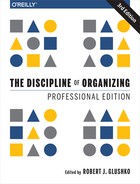7.5. Classification by Activity Structure
Institutional classification systems are often strongly hierarchical and taxonomic because their many users come to them for diverse purposes, making a context-free or semantic organization the most appropriate. However, in narrow domains that offer a more limited variety of uses it can be much more effective to classify resources according to the tasks or activities they support. A task or activity-based classification system is called a taskonomy, a term invented by anthropologists Janet Dougherty and Charles Keller after their ethnographic study of how blacksmiths organized their tools. Instead of keeping things together according to their semantic relationships in what Donald Norman called “hardware store organization,” the blacksmiths arranged tools in locations where they were used— “fire tools,” “stump tools,” “drill press rack tools,” and so on.433[Cog]
[433][Cog] See (Dougherty and Keller 1985) for the ethnography of blacksmithing, and also (Norman 2006), who extends the taskonomy idea to the design of user interfaces for cell phones and other computing devices. You probably have not worked as blacksmith, but you have certainly used taskonomic classification. For example, a student writing a term paper or doing a course project checks out books from the library’s taxonomic classification system (or prints them out from the web) and then organizes them in piles on a desk or on the floor according to the plan for the paper or project. Some of the original classification might persist, but the emphasis clearly shifts toward getting work done. When the task is completed the books go back to the library and are put back into the context-free taxonomy.
Personal organizing systems are often taskonomic. Think about the way you cook when you are following a recipe. Do you first retrieve all the ingredients from their storage places, and arrange them in activity-based groups in the preparation area?434[Cog]
[434][Cog] See (Kirsh 1995) for theoretical motivation and a classification scheme for the “intelligent use of space,” and (de Leon 2003) for an example of cooking ethnography.
Looking at the relationship between tasks and tools in this way can help a cook determine the best way to organize tools in a kitchen. Cutting items would necessarily be kept together near a prep area; having to run across the kitchen to another area where a poultry knife is kept with, say, chicken broth would be detrimental to the cook’s workflow. It would make far more sense to have all of the items for the task of cutting in a single area.
The intentional arrangement of tools in a working kitchen might look something like Table 7.1:
| Prep | Oven | Stove |
| Poultry knife | Oven mitts | Pots and pans |
| Paring knife | Baking sheets | Wooden spoons |
| Vegetable knife | Aluminum foil | Wok |
| Cutting board | Parchment paper | |
| Roasting pan |
